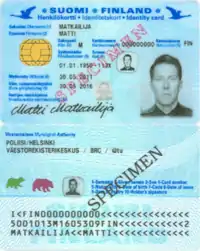Finnish identity card
The Finnish identity card (Finnish: henkilökortti / Swedish: identitetskort) is one of two official identity documents in Finland, the other being the Finnish passport. Any citizen or resident can get an identification card.[1] Finnish citizens will get indication of citizenship on the card. It is available as an electronic ID card (Finnish: sähköinen henkilökortti; Swedish: elektroniskt identitetskort), which enables logging into certain services on the Internet, local computers or adding digital signatures into LibreOffice ODF documents or creating DigiDoc formatted containers that also allows encryption during content transfer. ID card is applied at a police station and it is issued by the police.


Possession of an ID card or any ID document is non-compulsory in Finland, though interactions with officials and companies, like voting, picking up a parcel from Posti offices or buying alcohol when a salesperson suspects buyer to be under 18 or 20 years old, can be difficult or impossible without an ID card, a passport or a driving licence.
Driving licences and KELA (social security) cards with a photo are also widely used for general identification purposes even though they are not officially recognised as such. However, KELA has ended the practice of issuing social security cards with the photograph of the bearer, while it has become possible to embed the social security information onto the national ID card.
In domestic non-electronic identification the driving licence has remained in a leading position, since most of the population have to have a licence anyway, and a driving licence is valid for almost every situation where non-electronic personal identification is needed.
In some cases, an emergency ID card, valid between 15 days to 3 months, is issued.
Travel document
The Finnish identity card for citizens may be used as a travel document all over Europe (except Belarus, Russia, Turkey and Ukraine) as well as French overseas territories and Georgia. However, due to Finnish regulations, direct outbound travel from Finland to non-EU/EFTA countries requires a passport. From 2 August 2021, the European identity card[2][3] is intended to replace and standardize the various identity card styles currently in use in the EU/EEA.[lower-alpha 1][5][6]
For travel within the Nordic countries no identity documentation is legally required for Nordic citizens due to the Nordic Passport Union.
Electronic ID Card
The electronic card was introduced in 1999 and the current version, which is valid for 5 years, was introduced in 2003.[7] All issued ID cards nowadays are electronic with the exception of card for minors and temporary cards.
It was initially planned as a general network authentication device for both public and private sector strong authentication needs. In 2009, however, the card was viewed by a government committee as a failure. There has been less than 300000 cards around by 2011 out of population of 5.3 million. The rationale to apply for a card has mostly been traveling abroad. Only few dozen government services have adopted it, and only one bank adopted it as login card to their netbank. All banks in Finland use a national standard called TUPAS, which uses one-time passwords. Banks also provide TUPAS authentication to other Internet-enabled businesses. Since TUPAS requires no dedicated hardware, cost of a card reader and card itself have been main causes in the failure of the eID card.
Also the card itself is quite expensive, 51 € in 2011.[8] Earlier cost for a passport of the same 5 year validity period was the same as the cost of an ID card. In 2011 passport is only 2 € more expensive. Thus pricing and validity period have also been too close to passport and have offered no benefits compared to passport with the exception of being easier to carry in a wallet or a handbag. As of 2015, the card costs 55 € compared to 48 € for a passport (for both documents, if applied for online there will be a 4 € discount).[9]
In 2009 a committee recommended discontinuation of eID card. The card and certification service development and maintenance costs were listed as being excessive compared to limited use the card had seen.[10] However, as of 2011 no action has been taken regarding the card or the citizen certificate. Finnish eID card experience, which is based on voluntary adoption and users-pay-full-costs-of-the-cards model, has proven to be a very different experience when compared to for example neighboring Estonian ID card.
Notes
- The legal acquis has been identified as EEA-relevant by the EU Commission, which makes it under scrutiny for incorporation into the EEA Agreement by Iceland, Liechtenstein and Norway. However, the legal basis rely on Article 21 of the Treaty on the Functioning of the European Union, an article which is not reflected in the EEA Agreement.[4]
References
- "Poliisi - Applying for an identity card". www.poliisi.fi.
- "The legal and political context for setting up a European identity document" (PDF). Directorate-General for Internal Policies. 2016.
- "Proposal for a REGULATION OF THE EUROPEAN PARLIAMENT AND OF THE COUNCIL on strengthening the security of identity cards of Union citizens and of residence documents issued to Union citizens and their family members exercising their right of free movement" (PDF). European Commission. 2018.
- "Fri bevegelse av personer: styrket sikkerhet av ID-kort og oppholdsdokumenter | europalov". europalov.no. Retrieved 2020-09-04.
- "Regulation (EU) 2019/1157 of the European Parliament and of the Council of 20 June 2019 on strengthening the security of identity cards of Union citizens and of residence documents issued to Union citizens and their family members exercising their right of free movement". European Free Trade Association. Retrieved 2020-06-16.
- "Improving security for EU ID cards" (PDF). European Parliamentary Research Service. 2020.
- "News about launch of 5 year eID card". Archived from the original on April 26, 2012.
- "eID card pricing, Finnish Police". Archived from the original on 2012-01-05. Retrieved 2011-12-14.
- "Archived copy". Archived from the original on 2015-06-28. Retrieved 2015-07-25.CS1 maint: archived copy as title (link)
- "Helsingin Sanomat article about future of the card".